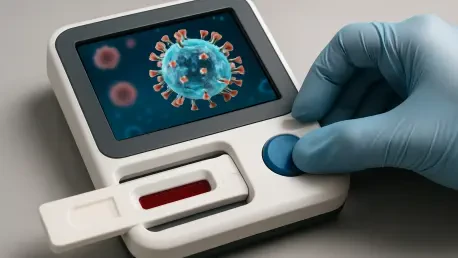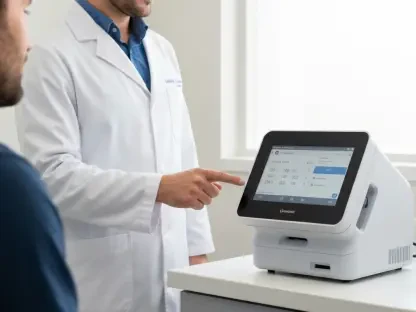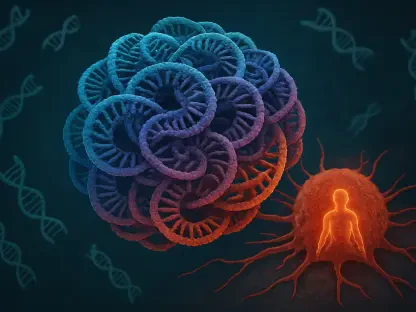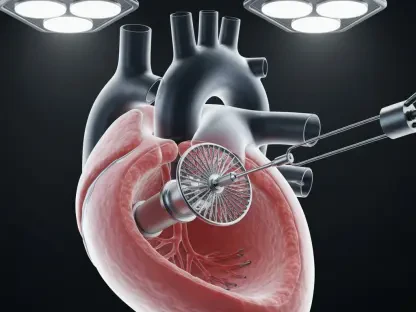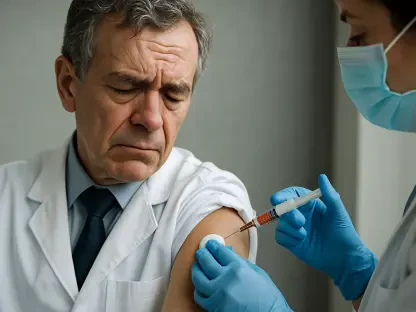Imagine a rural clinic in a low-resource region, where a patient arrives with symptoms of a deadly infectious disease, yet the nearest diagnostic lab is hundreds of miles away, and results could take days or even weeks. This scenario plays out daily across the globe, contributing to the staggering toll of over 10 million deaths annually from infectious diseases, as reported by global health organizations. Timely diagnosis remains a critical barrier in combating such public health crises, underscoring the urgent demand for innovative solutions. Rapid diagnostic tools have emerged as a transformative trend, promising to deliver fast, affordable, and accurate results in diverse settings, from remote villages to urban hospitals. This analysis explores the rise of these technologies, spotlighting groundbreaking innovations like NasRED, real-world applications, expert perspectives, and the future potential of this vital trend in global health.
The Rise of Rapid Diagnostic Technologies
Surging Demand and Market Expansion
The global diagnostics market is witnessing unprecedented growth, driven by an escalating need for point-of-care testing solutions. Industry reports project that the market for rapid diagnostics will continue to expand significantly over the coming years, with a particular focus on accessible and affordable tools. This surge is fueled by the persistent burden of infectious diseases, which disproportionately affect low- and middle-income countries where access to traditional lab-based testing remains limited. The push toward decentralized diagnostics reflects a broader shift in healthcare, prioritizing speed and accessibility to save lives through early intervention.
Adoption trends indicate a remarkable pivot toward portable and cost-effective solutions, especially in regions with constrained healthcare infrastructure. Data from health studies reveal that rapid diagnostic tools are increasingly integrated into primary care settings, enabling frontline workers to make swift decisions without relying on distant facilities. This market evolution is not just a response to immediate needs but a proactive step toward building resilient health systems capable of handling outbreaks and routine care alike.
Spotlight on NasRED: A Revolutionary Breakthrough
Among the most promising advancements in rapid diagnostics is NasRED (Nanoparticle-Supported Rapid Electronic Detection), developed by researchers at Arizona State University. This cutting-edge technology can detect multiple diseases, including COVID-19, Ebola, AIDS, and Lyme disease, using just a single drop of blood. Its ability to deliver results in a mere 15 minutes at an approximate cost of $2 per test positions it as a potential game-changer in the field of diagnostics.
What sets NasRED apart is its extraordinary sensitivity, reportedly 3,000 times greater than standard tests like ELISA, while requiring significantly less sample volume. The technology utilizes gold nanoparticles coated with antibodies to identify disease markers at incredibly low concentrations, making early detection possible even when symptoms are not yet apparent. This feature is critical for managing diseases that progress rapidly if left untreated.
Preliminary applications of NasRED have already demonstrated success in identifying diverse health threats, such as Shiga toxin-producing E. coli and cancer biomarkers. These early results highlight the tool’s versatility and potential to address not only infectious diseases but also other serious conditions. As a scalable solution, NasRED exemplifies how innovation can bridge diagnostic gaps across varied healthcare environments.
Expert Perspectives on Rapid Diagnostics
Insights from Innovators and Industry Leaders
Associate Professor Chao Wang, the lead researcher behind NasRED, emphasizes the technology’s capacity to revolutionize disease detection by enabling early intervention. According to Wang, the tool’s design prioritizes accessibility, aiming to empower healthcare providers in underserved areas with lab-quality results at a fraction of the cost. This vision aligns with the broader goal of reducing diagnostic disparities that hinder timely treatment worldwide.
Beyond the development team, public health experts across the industry underscore the significance of point-of-care diagnostics in preventing outbreaks and improving patient outcomes. Many highlight that rapid tools can serve as a first line of defense during epidemics, allowing for immediate containment measures. Such expert consensus points to a growing recognition of rapid diagnostics as indispensable in modern healthcare strategies, particularly for managing infectious threats.
Balancing Optimism with Practical Challenges
Despite the enthusiasm, experts also caution against overlooking hurdles that could slow the widespread adoption of these technologies. Regulatory approvals pose a significant challenge, as ensuring compliance with diverse international standards requires time and resources. Additionally, the need for further miniaturization and user training is often cited as a barrier to integrating such tools into everyday clinical practice. Addressing these issues will be crucial to realizing the full potential of rapid diagnostics in varied global contexts.
Future Horizons for Rapid Diagnostic Tools
Envisioning Home-Use and Wider Accessibility
Looking ahead, technologies like NasRED hold the promise of evolving into home-use kits, akin to over-the-counter pregnancy tests or rapid COVID-19 assays, but with far greater sensitivity and scope. Such a development could empower individuals to monitor their health routinely without needing to visit a healthcare facility. This shift toward personal diagnostics would mark a significant milestone in making medical testing as commonplace as other household health tools.
Expanding Applications and Technological Advancements
Anticipated advancements in rapid diagnostics include automation and broader applications beyond infectious diseases. Researchers are exploring ways to adapt platforms like NasRED for detecting chronic conditions such as cancer or Alzheimer’s, leveraging the technology’s modular design to target different biomarkers. This versatility could redefine how complex diseases are diagnosed and managed, potentially reducing the burden on specialized medical centers through early and accurate detection.
Navigating Scalability and Integration Challenges
While the benefits are clear, challenges such as scalability and integration into existing healthcare systems remain. Ensuring consistent accuracy across diverse populations and environments is a key concern, as is the logistical complexity of mass production and distribution. Nevertheless, the potential to reduce diagnostic errors and enhance global health equity through these innovations offers a compelling case for sustained investment and collaboration among stakeholders in the medical field.
Reflecting on a Transformative Journey
Looking back, the journey of rapid diagnostic tools like NasRED represents a pivotal shift in how the world approaches disease detection. Their ability to combine speed, affordability, and precision has already begun to reshape public health landscapes, offering hope in regions long plagued by diagnostic delays. As this trend gains momentum, it becomes evident that such innovations are not merely technological feats but lifelines for millions. Moving forward, the focus shifts to actionable steps—securing funding for broader deployment, fostering partnerships to streamline regulatory processes, and prioritizing education for healthcare providers to maximize impact. These efforts aim to ensure that the promise of rapid diagnostics translates into tangible improvements, paving the way for a healthier, more equitable global community.
